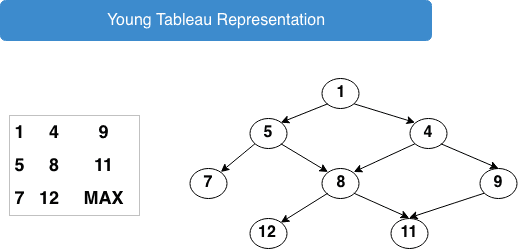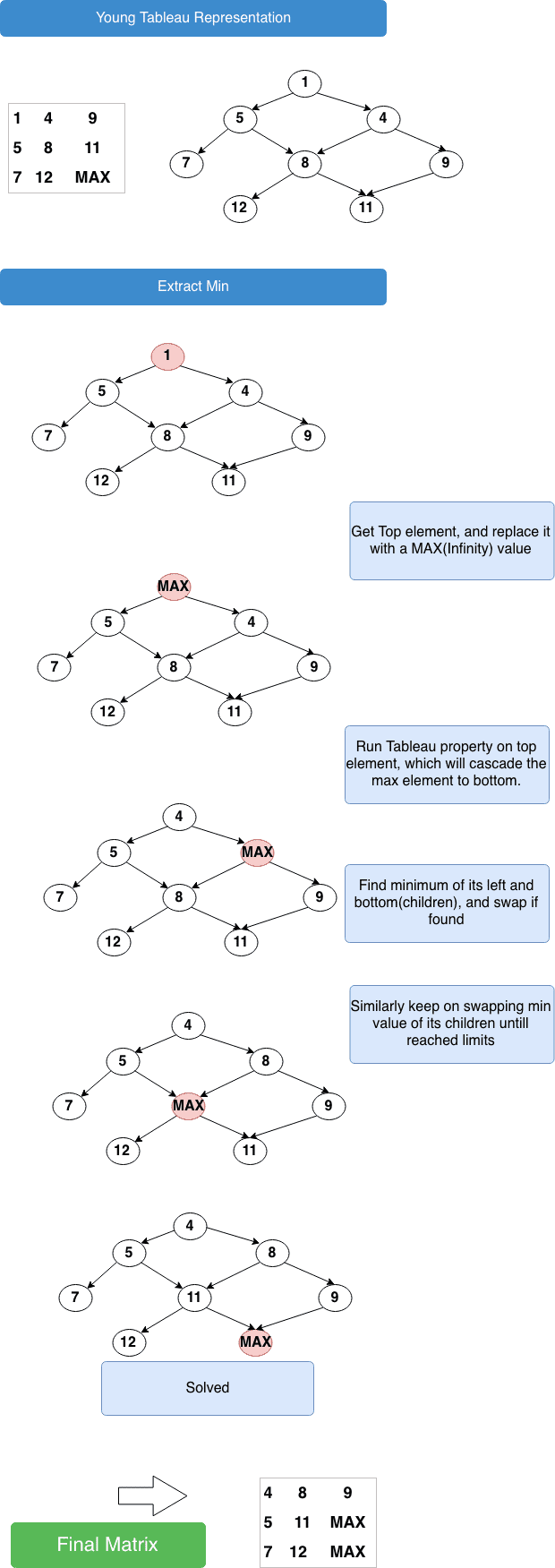Index for Coding Problems
Sorting Problems Merge Sort Quick Sort Heap Sort Bubble Sort Selection Sort…
July 12, 2019
A a X b matrix is Young Tableau if all rows(from left to right) and columns(from top to bottom) are sorted. Some of the entries in matrix can be an INFINITY (MAX) value to represent that its not a valid value.
1 5 9
4 7 11
8 12 MAX There are majorly three operations supported here:
Given an input matrix, you want to make it honor young tableau property.
The minimum that resides on (0,0) position. Return it, and delete from matrix. We need to do some swap operations in order to make this matrix again as Young Tableau.
Given an element, we need to search in matrix and return its index in matrix.
Before we get started, lets understand some basics. This problem can be considered as a modified case of Min-Heap data structure. Where all elements below the root element are lesser. Here, we the the children of a matrix cell will be its right and bottom cells.

/**
* Return [-1,-1], if there is no child element
*/
private int[] getLeft(int r, int c) {
if (r >= this.size-1) {
return new int[]{-1, -1};
}
return new int[]{r+1, c};
}
/**
* Return [-1,-1], if there is no child element
*/
private int[] getRight(int r, int c) {
if (c >= this.size-1) {
return new int[]{-1, -1};
}
return new int[]{r, c+1};
}
/**
* Check if the cell is within the matrix
*/
private boolean isCellValid(int[] cell) {
return cell[0]>=0 && cell[0]<this.size && cell[1]>=0 && cell[1]<this.size;
}private void tableau_heapify(int r, int c) {
int[] left = this.getLeft(r, c);
int[] right = this.getRight(r, c);
int[] smallest = new int[]{r, c};
// System.out.println(r + ", " + c);
//check if the cell is less than both of its children
if (this.isCellValid(left) && this.matrix[left[0]][left[1]] < this.matrix[r][c]) {
//save address of left cell
smallest = left;
}
if (this.isCellValid(right) && this.matrix[right[0]][right[1]] < this.matrix[smallest[0]][smallest[1]]) {
//save address of right cell
smallest = right;
}
//Check if we found changed address in our smallest variables.
//If yes, swap them. And, recursively call this method on that cell address
if (this.isCellValid(smallest) && (smallest[0] != r || smallest[1] != c)) {
//swap
int t = this.matrix[r][c];
this.matrix[r][c] = this.matrix[smallest[0]][smallest[1]];
this.matrix[smallest[0]][smallest[1]] = t;
// recursive call tableau_heapify
this.tableau_heapify(smallest[0], smallest[1]);
}
}It runs on an cell index, and check whether both children cells are lesser than or not. If not, swap with the minimum cell value, and keep on moving like this in recursion. Key points for heapify operation:
/**
* Get element at (0,0), and make matrix tableau_heapify again
*/
public int extractMin() {
int min = this.matrix[0][0];
//put a max value here, just to denote that it has been taken out.
this.matrix[0][0] = Integer.MAX_VALUE;
//lets maintain tableau property
this.tableau_heapify(0, 0);
//all is set
return min;
}Key points:
/**
* a recursive method to search an element
* @return null if not found
*/
private int[] search(int element, int[] currentCell) {
if (!this.isCellValid(currentCell)) {
return null;
}
int currentElement = this.matrix[currentCell[0]][currentCell[1]];
if (element == currentElement) {
return currentCell;
}
if (element < currentElement) {
// move left
// decrement col by 1
currentCell[1]--;
return this.search(element, currentCell);
}
else { //(element > currentElement) {
//move down
//increment row by 0
currentCell[0] ++;
return this.search(element, currentCell);
}
}
/**
* Search the given element and return its index in matrix
*/
public int[] searchElement(int element) {
//we will start from top right corner to find the element
return this.search(element, new int[]{0, this.size-1});
}Key points:

public class YoungTableau {
private int[][] matrix;
private int size;
public YoungTableau(int[][] matrix, int size) {
this.matrix = matrix;
this.size = size;
//build young tableau from given matrix
this.buildYoungTableau();
}
@Override
public String toString() {
StringBuffer sb = new StringBuffer();
for (int i=0; i<this.size; i++) {
for (int j=0; j<size; j++) {
sb.append(this.matrix[i][j]).append(" ");
}
sb.append("\n");
}
return sb.toString();
}
/**
* Return [-1,-1], if there is no child element
*/
private int[] getLeft(int r, int c) {
if (r >= this.size-1) {
return new int[]{-1, -1};
}
return new int[]{r+1, c};
}
/**
* Return [-1,-1], if there is no child element
*/
private int[] getRight(int r, int c) {
if (c >= this.size-1) {
return new int[]{-1, -1};
}
return new int[]{r, c+1};
}
/**
* Check if the cell is within the matrix
*/
private boolean isCellValid(int[] cell) {
return cell[0]>=0 && cell[0]<this.size && cell[1]>=0 && cell[1]<this.size;
}
/**
* Main the property of young tableau
*/
private void tableau_heapify(int r, int c) {
int[] left = this.getLeft(r, c);
int[] right = this.getRight(r, c);
int[] smallest = new int[]{r, c};
// System.out.println(r + ", " + c);
//check if the cell is less than both of its children
if (this.isCellValid(left) && this.matrix[left[0]][left[1]] < this.matrix[r][c]) {
//save address of left cell
smallest = left;
}
if (this.isCellValid(right) && this.matrix[right[0]][right[1]] < this.matrix[smallest[0]][smallest[1]]) {
//save address of right cell
smallest = right;
}
//Check if we found changed address in our smallest variables.
//If yes, swap them. And, recursively call this method on that cell address
if (this.isCellValid(smallest) && (smallest[0] != r || smallest[1] != c)) {
//swap
int t = this.matrix[r][c];
this.matrix[r][c] = this.matrix[smallest[0]][smallest[1]];
this.matrix[smallest[0]][smallest[1]] = t;
// recursive call tableau_heapify
this.tableau_heapify(smallest[0], smallest[1]);
}
}
private void buildYoungTableau() {
for (int i=this.size-1; i>=0; i--) {
for (int j=this.size-1; j>=0; j--) {
this.tableau_heapify(i, j);
}
}
}
/**
* Get element at (0,0), and make matrix tableau_heapify again
*/
public int extractMin() {
int min = this.matrix[0][0];
//put a max value here, just to denote that it has been taken out.
this.matrix[0][0] = Integer.MAX_VALUE;
//lets maintain tableau property
this.tableau_heapify(0, 0);
//all is set
return min;
}
/**
* a recursive method to search an element
* @return null if not found
*/
private int[] search(int element, int[] currentCell) {
if (!this.isCellValid(currentCell)) {
return null;
}
int currentElement = this.matrix[currentCell[0]][currentCell[1]];
if (element == currentElement) {
return currentCell;
}
if (element < currentElement) {
// move left
// decrement col by 1
currentCell[1]--;
return this.search(element, currentCell);
}
else { //(element > currentElement) {
//move down
//increment row by 0
currentCell[0] ++;
return this.search(element, currentCell);
}
}
/**
* Search the given element and return its index in matrix
*/
public int[] searchElement(int element) {
//we will start from top right corner to find the element
return this.search(element, new int[]{0, this.size-1});
}
public static void main(String[] args) {
int[][] matrix = {
{12, 7, 11},
{8, 9, 1},
{4, 5, Integer.MAX_VALUE}
};
YoungTableau t = new YoungTableau(matrix, 3);
System.out.println(t);
System.out.println("------------------");
System.out.println("Searching index of 8: " + ArrayUtils.toString(t.searchElement(8)));
System.out.println("Searching index of 12: " + ArrayUtils.toString(t.searchElement(12)));
System.out.println("Searching index of 4: " + ArrayUtils.toString(t.searchElement(4)));
System.out.println("Searching index of 1: " + ArrayUtils.toString(t.searchElement(1)));
System.out.println("Min: " + t.extractMin());
System.out.println("------------------");
System.out.println(t);
System.out.println("------------------");
System.out.println("Min: " + t.extractMin());
System.out.println("------------------");
System.out.println(t);
System.out.println("------------------");
System.out.println("Min: " + t.extractMin());
System.out.println("------------------");
System.out.println(t);
System.out.println("------------------");
System.out.println("Min: " + t.extractMin());
System.out.println("------------------");
System.out.println(t);
System.out.println("------------------");
}
}Sorting Problems Merge Sort Quick Sort Heap Sort Bubble Sort Selection Sort…
Problem Statement You are given an array of integers. And, you have find the…
A number consists of digits. Example: 843. Its a 3-digit number. Radix sort…
Problem Statement Determine if a 9x9 Sudoku board is valid. Only the filled…
Problem Statement Given an array of integers, return indices of the two numbers…
Problem Statement Given a Binary tree, print out nodes in level order traversal…
Introduction In this post we will see following: How to schedule a job on cron…
Introduction There are some cases, where I need another git repository while…
Introduction In this post, we will see how to fetch multiple credentials and…
Introduction I have an automation script, that I want to run on different…
Introduction I had to write a CICD system for one of our project. I had to…
Introduction Java log4j has many ways to initialize and append the desired…